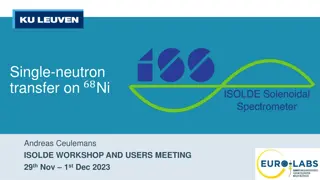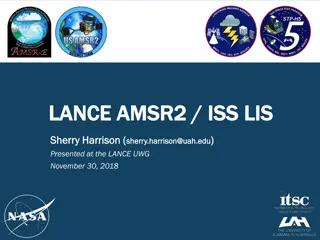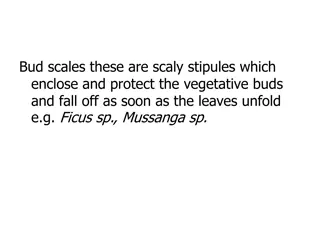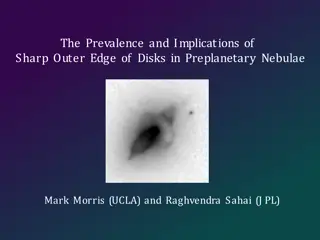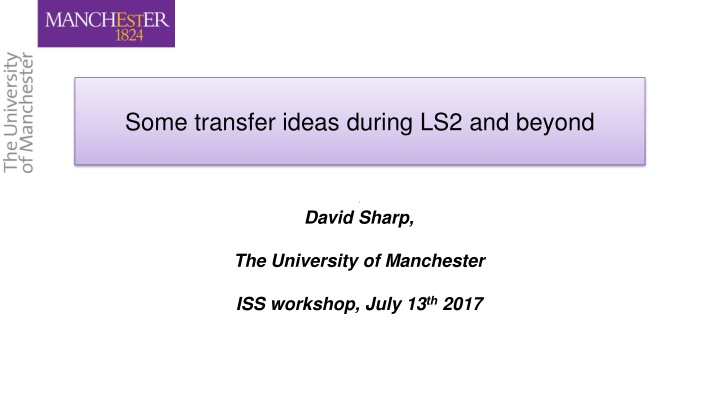
Emerging Trends in Nuclear Structure Studies Post-LS2
Explore the evolution of single-particle structure in light and stable nuclei, uncovering significant changes and interactions affecting shell closures. Gain insights into the dynamics of neutron-rich isotopes/isotones and the impact of proton-core coupling on nuclear behavior. Discover new approaches to measuring high-j single-particle strengths and investigating the effects of tensor interactions in nuclear research beyond LS2 and into the future.
Download Presentation

Please find below an Image/Link to download the presentation.
The content on the website is provided AS IS for your information and personal use only. It may not be sold, licensed, or shared on other websites without obtaining consent from the author. If you encounter any issues during the download, it is possible that the publisher has removed the file from their server.
You are allowed to download the files provided on this website for personal or commercial use, subject to the condition that they are used lawfully. All files are the property of their respective owners.
The content on the website is provided AS IS for your information and personal use only. It may not be sold, licensed, or shared on other websites without obtaining consent from the author.
E N D
Presentation Transcript
Some transfer ideas during LS2 and beyond David Sharp, The University of Manchester ISS workshop, July 13th 2017
Evolution of single-particle structure Study of the evolution of single-particle structure in light neutron-rich systems has led to discoveries of dramatic changes leading to the weakening and appearance of shell closures. Such changes can be interpreted as arising from effects of the valence nucleon interactions, where increasing occupation of a particular valence proton orbital will have a larger interaction on valence neutrons, for example. C. Hoffman et al, Phys. Lett. B 672 17 (2009) D. Steppenbeck et al, Nature 502 207 (2013) T.Otsuke and D. Abe Prog. In Particle and Nuclear Physics 59 425 (2007)
Evolution of single-particle structure Similarly trends have even been observed in stable heavier nuclei. Studies of chains of isotopes/isotones have pointed to fairly robust mechanisms for these changes such as the requirement to include a tensor interaction (N=51, Z=51, N=83). Access to RIBs at HIE-ISOLDE will allow access to measurements across large chains of isotopes/isotones probing the interactions further from stability. h11/2 h11/2 g7/2 proton neutron D.K. Sharp et al, Phys.Rev.C 87 014312 (2013) Otsuka et al. Phys. Rev. Lett. 95, 232502 (2005)
N=83 isotones Stable N=82 targets have been used to investigate trends in high-j single-particle strengths. The behaviour of the deduced centroids is consistent with the effects of the tensor interaction. Fragmentation of the h11/2 and i13/2 states is quite high due to extensive coupling with quadrupole and octupole vibrational states in the core, so measured spectroscopic factors are essential to disentangle the resulting energy centroids. At Z=64 the particle-core coupling to the vibrational states is expected to be strongest. B. P. Kay et al, Phys.Lett.B 658 216 (2008) B. P. Kay et al, Phys.Rev.C 84 024325 (2011)
N=83 isotones Away from stability the proton Fermi surface moves from filling predominantly the g7/2 to the h11/2. As such the sense of the tensor interaction reverses which should cause the difference in the energies to increase again. Measurements of neutron-adding reactions using N=82 beams will allow an investigation of this behaviour. What effect does the particle-core coupling play? Need to carefully consider fragmentation. Rates from yield database assuming 10% transmission to ISS: 146Gd(Z=64) 107 pps 148Dy (Z=66) 105-7 pps 150Er (Z=68) 105 pps B. P. Kay et al, Phys.Lett.B 658 216 (2008) B. P. Kay et al, Phys.Rev.C 84 024325 (2011)
Sn isotones Previous measurement of proton-adding reaction using stable targets investigated evolution of high-j single-particle strength. Robust measurements of neutron-adding and -removing reactions of even stable Sn isotopes have been recently made, probing neutron single-particle energies and occupancies. Opportunity to expand these measurements at HIE-ISOLDE allowing a study of the evolution of neutron and proton single-states from 106- 134Sn 28 neutrons. Occupancy 12 16 24 20 4 8 0 2s1/2 0g7/2 0h11/2 1d 112 Would require a gas cell in the future to make (a,t) or (3He,d) measurements to populate proton states. 114 116 118 A 106-110Sn and 128-134Sn >105 pps. 126Sn long-lived beam. 120 122 124 Protons - J. P. Schiffer et al., Phys. Rev. Lett. 92, 162501 (2004) Neutrons - D.K. Sharp et al, In preparation
126Sn(d,p) Evolution along Z=50 The (d,p) reaction will be used to probe the vacancy of the orbitals in 126Sn as well as confirming the location of the low-lying single-particle states in 127Sn. Outside stable targets (d,p) measurements have previously been made on 130,132Sn. These data will help complete the picture of the evolution of these single-particle orbitals away from the stable tins towards the shell closure at 132Sn. Expanding on a systematic study of the stable Sn. The case of 126Sn (T1/2 = 2.3E5 years) is directly produced when protons are incident on Ucx targets and is volatile enough to be released from a hot target and so may require the irradiation of a cold target to maximise the yield.
Single-particle evolution along N=126 N=126 isotones and Pb isotopes provide further testing grounds for evolving shell-structure and modern shell-model calculations. (d,p) reaction probes single-neutron states in N=127 nuclei. Along N=127 there is little data which is directly sensitive to the single-particle behaviour. Some data exists on 211Po but there are missing assignments. Measurements of these states in nuclei up to Z=88 are feasible at HIE-ISOLDE with ISS. 210Po (Z=84) long-lived beam. 212Rn (Z=86) 107 pps. 214Ra (Z=88) 105 pps.
210Po(d,p) Single-particle evolution along N=126 Measurements of single-neutron properties of 211Po using a long lived 210Po beam is the first step in probing along this isotonic chain north of 208Pb. 210Po (T1/2=138 days) is directly produced when protons are incident on Ucx targets and is volatile enough to be released from a hot target. Irradiation of a cold target unit may be required to maximise the 210Po yield. (d,p) reaction will be best suited to studying low-l states in the residual nucleus, though it will also populate higher-l orbitals.
210Pb(d,p) Single-particle states near N=126, Z=82 Nuclei near doubly-magic shell closures provide good testing grounds for shell-model calculations. 210Pb is only two neutrons from the doubly-magic shell closure at Z = 82 and N = 126. Neutron-adding on this nucleus will probe the 1g9/2, 0i11/2, 0j15/2, 2d5/2, 3s1/2, 1g7/2 and 2d3/2 single- particle strength in 211Pb to varying degrees. The reaction is best suited to the study of the 2d and 3s1/2 states, but will also locate the higher-j strength. These data will act as a test of modern shell model calculations and can be used to predict the evolution of single-particle structure further from doubly-magic 208Pb. Some previous (t,d) data exist, however, the measured angular distributions were somewhat featureless and therefore assignments are not necessarily reliable. In the decay chain of 228Th (T1/2 = 1.9 years), there is a waiting point at 210Pb (T1/2 = 22.2 years), which will have built up in UCx targets irradiated in the past. RILIS will be used to extract 210Pb beams from previously irradiated UCx targets. i.e. no new target irradiation required.
Single-particle evolution along Z=82 Very little single-particle information in neutron deficient Pb isotopes. Opportunity to study single-particle evolution over a large change in neutron excess. Lead beams covering a difference of 22 neutrons are feasible in terms of rates. 188-202Pb (N=106-120) 10^5-6 pps 210Pb (N=128) long-lived beam How does single-particle behaviour influence changes in structure in this region?
Single-particle evolution along Z=82 Shape coexistence in this region described by 2p-2h and 4p-4h excitations above N=82. How do proton-neutron interactions influence the onset of shape-coexistence in the Pb region? Use (d,p) reactions to probe single-particle energies and occupancies in neutron deficient Pb nuclei. Also Hg ... 13/2+ states may be of particular interest due to large overlap with protons populating h9/2 above N=82. Populated weakly in (d,p) though. Resolution limitations
Summary HIE-ISOLDE+ISS provide opportunities to extend studies of the evolution of single-particle behaviour to more exotic regions of the nuclear chart along long chains of isotopes and isotones. Several potential cases for measurements for after LS2 (N=82, Sn, Pb ). During LS2 first of these measurements can potentially be made with long-lived beams from old targets or cold irradiated targets.....LOI submitted.
r (cm) 10 20 30 40 50 0 -0.2 -0.1 0 15 o Cross section (mb/sr) 0.1 a( 132Sn,t) 133Sn, 10 MeV/u, 3 T 10 2 4 6 8 0 o Distance from target, z (m) 0 0.2 30 o 5 30 0.3 o 10 0.4 qcm 15 0.5 132Sn(a,t) 20 0.6 25 Array 4 MeV 0 MeV 0.7 30 2 4 0 3 0.8 1 r (cm) 0 10 20 30 40 50 0 -0.8 5 -0.7 10 Array qcm -0.6 15 132Sn( 3He,d) 20 -0.5 3He( 132Sn,d) 133Sn, 10 MeV/u, 2.75 T Distance from target, z (m) 25 -0.4 30 10 o -0.3 10 -0.2 o 30 o -0.1 30 o 0 4 MeV 0 MeV 0.1 0.2


